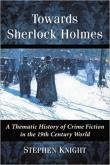 1665541052463665805.jpg
1665541052463665805.jpg
 Towards Sherlock Holmes: A Thematic History of Crime Fiction in the 19th Century World
multi chapter work
Towards Sherlock Holmes: A Thematic History of Crime Fiction in the 19th Century World
multi chapter work
 1665541052463665805.jpg
1665541052463665805.jpg
 Towards Sherlock Holmes: A Thematic History of Crime Fiction in the 19th Century World
multi chapter work
Towards Sherlock Holmes: A Thematic History of Crime Fiction in the 19th Century World
multi chapter work
'Crime fiction–a product of the burgeoning metropolis of the 19th century–features specialists who identify criminals to protect an anxious citizenry. Before detectives came to play the central role, the protagonists tended to be lawyers or other professionals. Major English writers like Gaskell, Dickens and Collins contributed to the genre–Fergus Hume's The Mystery of a Hansom Cab was a best-seller in 1887–and American and French authors created new forms. This book explores thematic aspects of 19th century crime fiction's complex history, including various social and gender roles between different time periods and settings, and the imperial elements that made Sherlock Holmes seem dynamically contemporary.' (Publication summary)
'Crime fiction has many authors, very many readers, and also a number of myths. One is that the whole thing started with Poe, a view favored by those unaware of earlier authors who developed the form before the brilliant Philadelphian made myth out of mystery and detection. Another is that Raymond Chandler was a great popular private-eye author—in fact his first novel sold in sober hardback and he was always better-received among the English literati of his own origin, a context which gave class and confidence to his reshaping of Hammett's edgy populism. The myths also have it that Sara Paretsky was the first of the feminist mystery authors—in fact several others preceded her by a decade or more, but they have been effectively obscured by the firmness and flourish which in her Chandleresque way she brought to the form, or the anti-form. A negative myth is the topic of this chapter—why has no-one ever offered any explanation for the runaway success of the first novel by an author who went on to write many with nothing of the same success, who set it in far-away Melbourne, Australia, and yet saw his novel The Mystery of a Hansom Cab take London by bibliocommercial storm in very late 1887, so much so it gained the title of the first best-seller in crime fiction? Unlike Fergus Hume's more than a hundred other novels, 40 more years of mysteries and sensational stories, the book has almost always been in print, usually in a cheap format and occasionally with a short, gesturing introduction. It has been at times mentioned as a freak and very rarely described in very limited detail. There is now from the Melbourne scholar Lucy Sussex a full account of the context, production and promotion of the book, and it seems time it came in from the critical cold.' (Introduction)